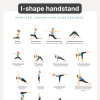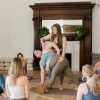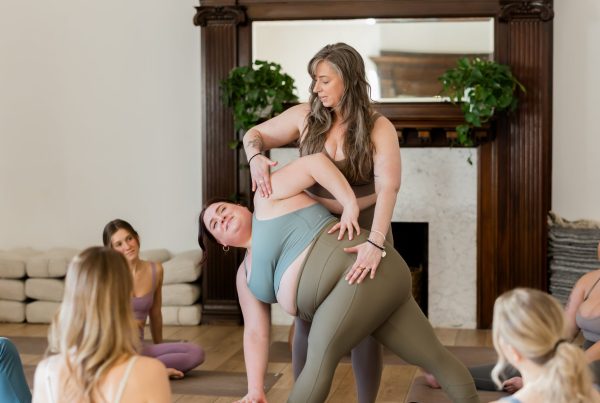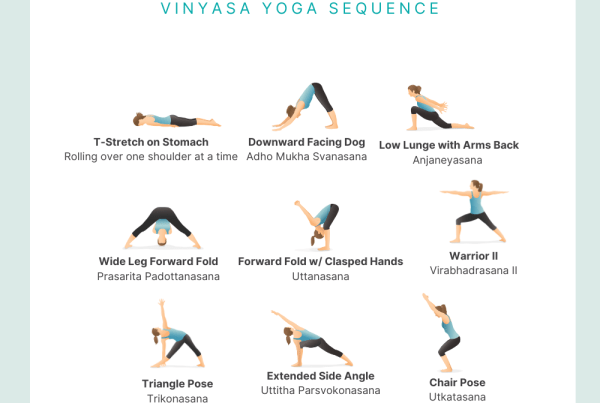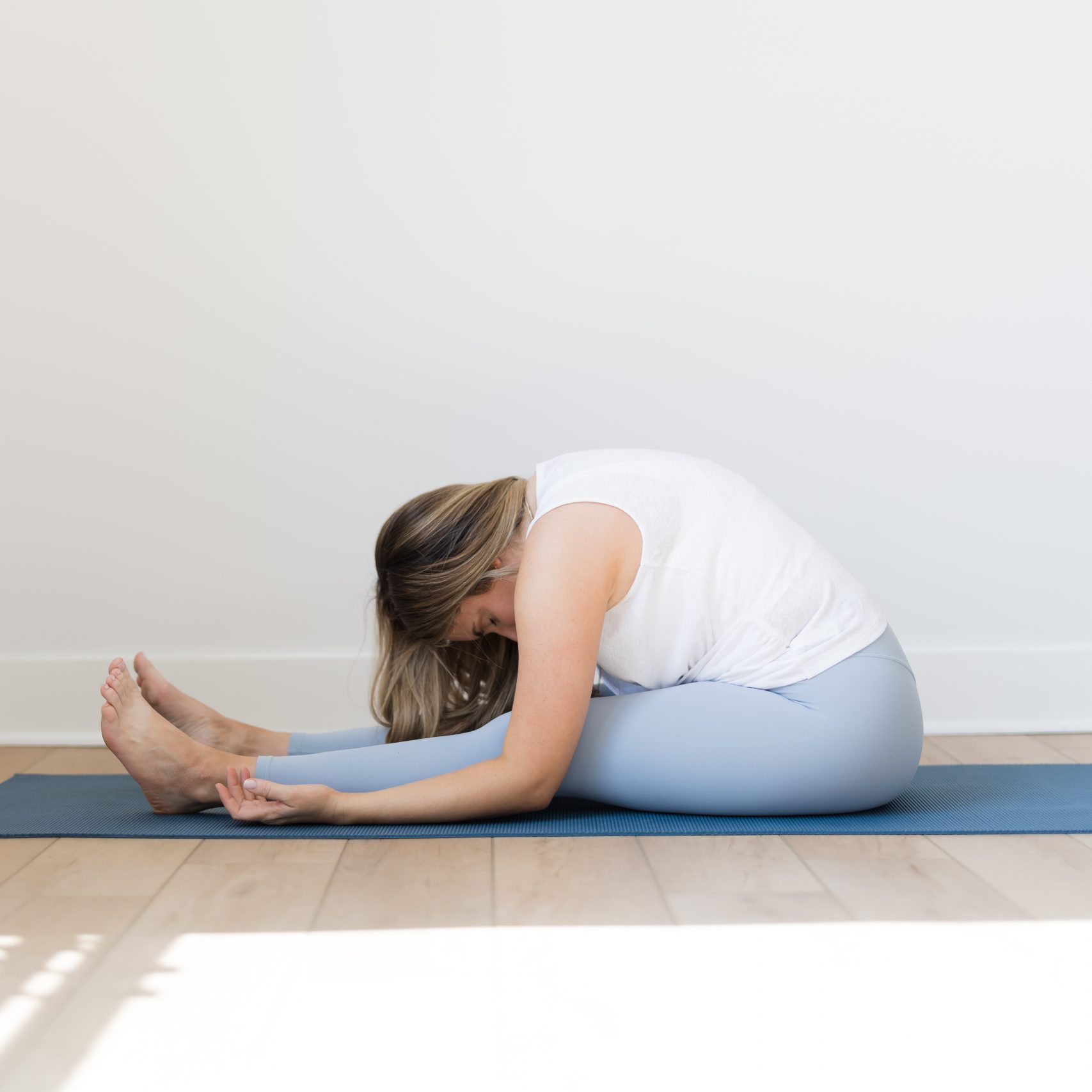
I’d been teaching yoga full time for almost four years before I did my yin yoga teacher training and started teaching yin classes. By that point, I was an ERYT 200 (meaning I had over 1,000 hours of teaching experience) and was about to begin my 300HR Advanced Teacher Training. And even though up until that point my classes had been mostly vinyasa style, I still felt pretty confident in my ability to lead students through a solid yoga class.
While there’s no doubt that my experience helped me with teaching in general, I quickly found out there were some key differences between leading active style yoga classes and yin yoga classes.
It took me a bit of time to fully understand the shift I had to make between my approach to teaching yin versus vinyasa, but once I figured out what I needed to do it made teaching yin yoga extremely enjoyable and I found it to be the perfect balance to my vinyasa yoga classes.
These simple tweaks to my teaching made all the difference in the environment I created for my students and helped them to cultivate a love for this practice.
1. Explain what yin yoga is
It’s easy to assume that if a student signed up for your yin yoga class then they know what yin yoga is, but I’ve found that most of the time that’s not the case. Students register for a yoga class for many different reasons– the time works, they like the teacher, their friend said it was great, etc– and if they’re a beginner student they may not even realize there are different styles of yoga. Even seasons practitioners may not really know what a yin yoga class entails if they’ve never taken one.
Starting your class off with a short elevator-pitch explanation of what yin yoga is and how the class will be structured can go a long way in setting you and your students up for success when it comes to creatine a positive experience. Knowledge is power and if you provide the rundown of how class will go, you’ll help your students have appropriate expectations for class.
It can sound something like this…
“Hello and welcome! I’m [your name]. Welcome to yin. This class is a little different than some of the more active forms of yoga you may be familiar with so I want to give you a quick rundown of how this class works.
In yin practice, we’ll passively hold each pose for 3-5 minutes– they’ll be mostly seated poses so not to worry– and we’ll work with gravity to slowly release and open the body. Our goal here is to help get into the connective tissue of your body where you really hold onto tension and tightness, so there’s not necessarily a “right” way to do the pose, but rather it’s more about what feels right for you.”
2. Cue & demonstrate getting into the poses
Yin yoga gives poses different names than their more well-known active yoga pose counterparts. The reason for this is that in taking a passive approach to the practice, the body actually moves into the poses differently than in the active versions, so yin seeks to differentiate the poses by giving them different names.
For example, butterfly pose in yin yoga closely resembles Baddha Konasana. But, in an active class a teacher will usually talk a lot about lengthening the spine to fold forward, which requires muscular engagement. In yin, you simply release the upper body down over the legs, even if that means the spine is very rounded.
As a result of this, if you say to students “we’re going to come into butterfly pose”, they may have no idea what you’re talking about as they likely aren’t familiar with the yin names unless they’re a seasoned yin practitioner.
Instead, just tell and show them what to do with their bodies in order to get into the pose. So for butterfly pose you can do the pose yourself as you say,
“Come to sit with both feet out in front of you and your knees bent. Bring the soles of your feet to touch and open your knees out wide. Breathe in and as you breath out release your head and belly towards your legs any amount, coming into butterfly pose. Stop when it feels like the right amount for you and use your breath to slowly fold deeper over time.”
By cueing the actions and showing them the pose before telling them the name, you give them confidence in their ability to do the pose rather than leaving them feeling confused or silly for not knowing the name and what to do.
3. Rely on yoga props
Even though doing hands-on adjustments in yin yoga is a big “no-no”, that doesn’t mean that you get a full pass in assisting your students.
After getting your students into each pose, look around the room and see what’s happening. Notice if a prop may help a student be more comfortable in holding the shape for a long time or if it could help them avoid misaligning a joint in a way that could be unsafe.
A basic prop set-up of: 2 blocks, 2 blankets, and a bolster can usually carry most students through a yin class. But, sometimes a student may need a third blanket in a specific pose. If they have to get up to grab one, it totally disturbs not only the energy of their practice, but of the students around them. Make sure you’re the one to get up and grab any additional props students may need.
This is a great way to show your students you’re paying attention to them, you’re present with them, and you’re holding space for them to move through their own individual practice. One little prop can go a looong way in helping a student have a more enjoyable experience in your class, so make sure to be on the lookout for how you can help.
4. Offer words of wisdom but also be quiet!
A five minute hold in sphinx pose (or any other pose of choice) can feel like an absolute eternity for some students during class and what you say as the teacher can make all the difference.
Spend the first minute or two in each pose guiding your students with some inspirational thoughts. This is also a great way to incorporate your own personal style or approach.
Maybe you’re super into poetry and have a poem you weave throughout your class. Or perhaps guided meditations are you thing and you can use that time to help lead some simple breathing exercises. You’ll need to find what works for you, but it’s helpful to give students something to listen to for the first few minutes as the settle into a pose.
But then… be quiet.
It’s super important that you balance those words of wisdom with intentional silence. Yin is all about tuning inwards and you want to make sure you give your students space and time to do that. Know that it may be difficult for them and you as the teacher may even pick up on some agitated energy as they secretly curse you for keeping them in the pose for that extra minute or two. That’s ok– it’s part of the practice. Remember that you’re giving them a gift by guiding them through the physical and emotional challenges this practice can bring and you’re helping them build resilience over time.
Want my full run-down on how to get started teaching yin yoga classes? Grab my totally free Yin Yoga Teacher Starter Kit, which will give you everything you need to know to teach your first yin yoga class.



